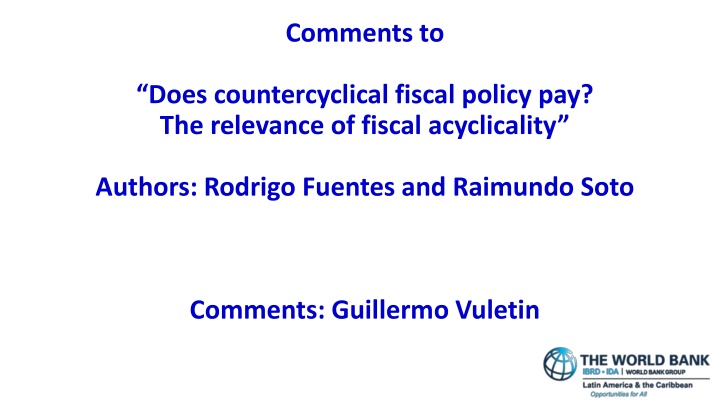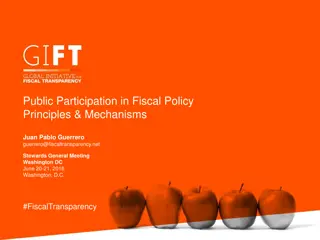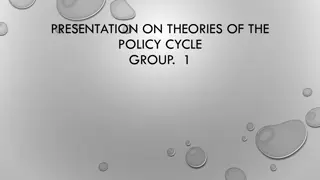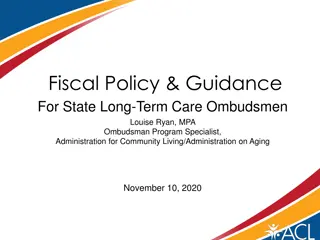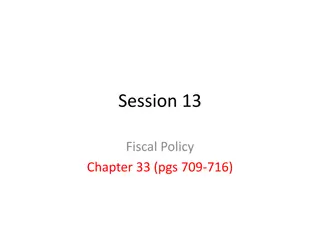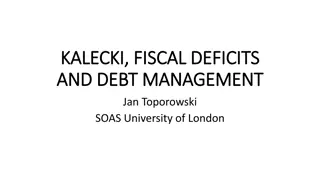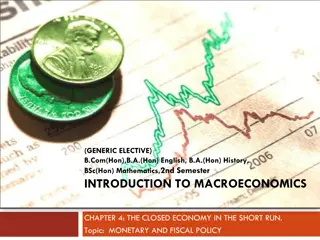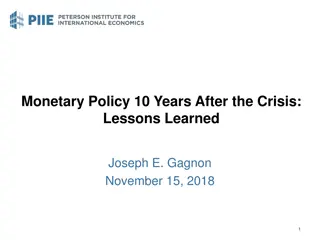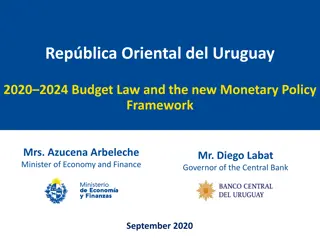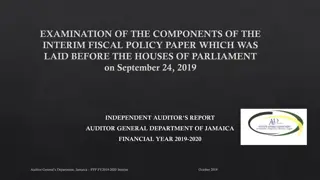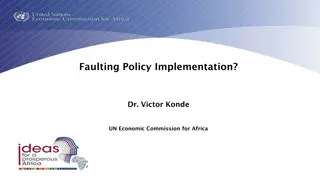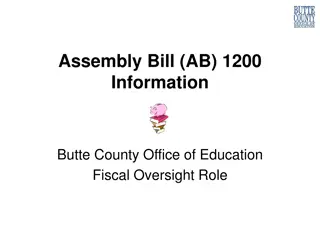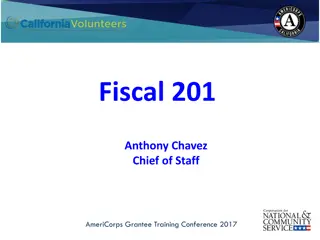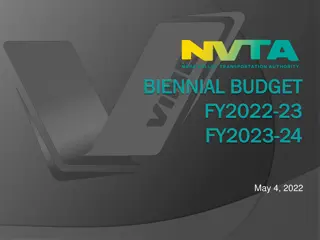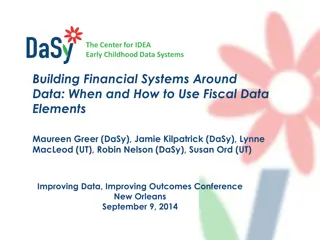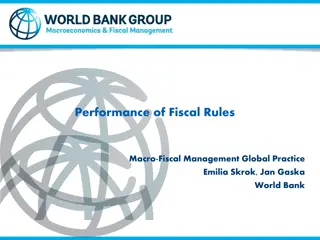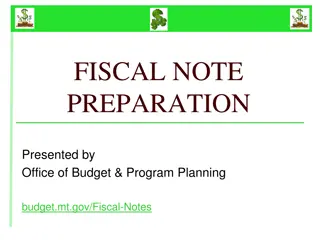Relevance of Countercyclical Fiscal Policy and Fiscal Acyclicality
This literature review examines the effectiveness of countercyclical fiscal policies in stabilizing output and enhancing welfare, with a focus on the correlation between public spending cycles and GDP cycles. The study analyzes examples from Sweden and Argentina to showcase the impact of fiscal policy on output volatility and growth. Additionally, it explores the operationalization of fiscal policy cyclicality stance through calculations of cyclical components in relevant variables.
Download Presentation

Please find below an Image/Link to download the presentation.
The content on the website is provided AS IS for your information and personal use only. It may not be sold, licensed, or shared on other websites without obtaining consent from the author.If you encounter any issues during the download, it is possible that the publisher has removed the file from their server.
You are allowed to download the files provided on this website for personal or commercial use, subject to the condition that they are used lawfully. All files are the property of their respective owners.
The content on the website is provided AS IS for your information and personal use only. It may not be sold, licensed, or shared on other websites without obtaining consent from the author.
E N D
Presentation Transcript
Comments to Does countercyclical fiscal policy pay? The relevance of fiscal acyclicality Authors: Rodrigo Fuentes and Raimundo Soto Comments: Guillermo Vuletin
Literature review Large macroeconomic literature studying how short-term fluctuations in public spending (and taxes) could help stabilize output, increasing people s welfare. Evaluate the second order impact on growth (via reduction in output volatility). No causal relation with debt sustainability (more to come later). How to operationalize the fiscal policy cyclicality stance? 1. Calculate the cyclical component of variables of interest (e.g., G and GDP): 2. Estimate relationship between cycle of G and cycle of GDP.
Literature review Main findings. Example, looking at big G in two usual suspects: Sweden Argentina
Literature review Main findings. Example, looking at big G in two usual suspects: Sweden Argentina 15 10 5 % deviation from trend 0 1983 1985 1987 1989 1991 1993 1995 1997 1999 2001 2003 2005 -5 -10 -15 -20 -25 Real GDP cycle Real gov. spending cycle -30 negative correlation (counter-cyclical)
Literature review Main findings. Example, looking at big G in two usual suspects: Sweden Argentina 30 15 20 10 10 5 % deviation from trend % deviation from trend 0 0 1986 1988 1990 1992 1994 1996 1998 2000 2002 2004 1983 1985 1987 1989 1991 1993 1995 1997 1999 2001 2003 2005 -10 -5 -20 -10 -30 -15 -40 -20 -50 -25 Real GDP cycle Real gov. spending cycle Real GDP cycle Real gov. spending cycle -60 -30 negative correlation (counter-cyclical) positive correlation (pro-cyclical)
Literature review Main findings. Example, looking at big G in two usual suspects: Sweden Argentina 30 15 20 10 10 5 % deviation from trend % deviation from trend 0 0 1986 1988 1990 1992 1994 1996 1998 2000 2002 2004 1983 1985 1987 1989 1991 1993 1995 1997 1999 2001 2003 2005 -10 -5 -20 -10 a-cyclicality -30 -15 -40 -20 -50 -25 Real GDP cycle Real gov. spending cycle Real GDP cycle Real gov. spending cycle -60 -30 negative correlation (counter-cyclical) positive correlation (pro-cyclical)
Literature review Main findings. Example, looking at big G in two usual suspects: Sweden Argentina 30 15 20 10 10 5 % deviation from trend % deviation from trend 0 0 1986 1988 1990 1992 1994 1996 1998 2000 2002 2004 1983 1985 1987 1989 1991 1993 1995 1997 1999 2001 2003 2005 -10 -5 -20 -10 a-cyclicality -30 -15 -40 -20 -50 -25 Real GDP cycle Real gov. spending cycle Real GDP cycle Real gov. spending cycle -60 -30 negative correlation (counter-cyclical) positive correlation (pro-cyclical) What does a-cyclicality mean? No systematic relationship between cycle of G and cycle of GDP Cycle of G 0 Cycle of GDP time
Literature review Main findings. Strong empirical regularity. Example using G for period 1960-1999 Pro-cyclical Counter-cyclical counter-cyclical pro-cyclical Update from Frankel, Vegh and Vuletin, (2013), On graduation from fiscal procyclicality, JDE
Literature review Main findings. Strong empirical regularity. Example using G for period 1960-1999 Pro-cyclical Caveat: We also use very serious analysis including panel regressions controlling for possible endogeneity (using IV approach) Counter-cyclical counter-cyclical pro-cyclical Update from Frankel, Vegh and Vuletin, (2013), On graduation from fiscal procyclicality, JDE
Literature review Main findings. Strong empirical regularity. Example using G for period 1960-1999 Pro-cyclical Counter-cyclical counter-cyclical pro-cyclical Update from Frankel, Vegh and Vuletin, (2013), On graduation from fiscal procyclicality, JDE
Literature review Main findings. Strong empirical regularity. Example using G for period 1960-1999 WTF? Pro-cyclical Counter-cyclical counter-cyclical pro-cyclical Update from Frankel, Vegh and Vuletin, (2013), On graduation from fiscal procyclicality, JDE
Literature review Main findings. Strong empirical regularity. Example using G for period 1960-1999 Where is The Failure? WTF? Pro-cyclical Counter-cyclical counter-cyclical pro-cyclical Update from Frankel, Vegh and Vuletin, (2013), On graduation from fiscal procyclicality, JDE
Literature review Main drivers of counter-cyclicality - Public investment: Classical Keynesian argument - Automatic stabilizers like unemployment insurance (UI) counter-cyclical counter-cyclical Galeano, Izquierdo, Puig, Vegh, and Vuletin, (2021), Can automatic government spending be procyclical?, R&R JMCB
Literature review Main drivers of counter-cyclicality - Public investment: Classical Keynesian argument - Automatic stabilizers like unemployment insurance (UI) counter-cyclical counter-cyclical Galeano, Izquierdo, Puig, Vegh, and Vuletin, (2021), Can automatic government spending be procyclical?, R&R JMCB
Literature review Main drivers of counter-cyclicality - Public investment: Classical Keynesian argument - Automatic stabilizers like unemployment insurance (UI) Effective coverage = Extensive margin (unemployed people covered by the unemployment insurance program) x Intensive margin (UI gross replacement rate) counter-cyclical counter-cyclical Galeano, Izquierdo, Puig, Vegh, and Vuletin, (2021), Can automatic government spending be procyclical?, R&R JMCB
Literature review Main drivers of Pro-cyclicality. WTF? - Political distortions and weak institutions: Policymakers short-sightedness and political pressure to spend when resources are available, among many other varieties of political economy-based reasons, encourage excessive public spending during boom periods, leaving few resources to spend in bad times. - Limited access to international credit markets, particularly in bad times. - Over-optimism in output forecasts Gavin, Hausmann, Perotti, and Talvi (1996), Gavin and Perotti (1997), Velasco (1997), Tornell and Lane (1999), Kaminsky, Reinhart, and Vegh (2004), Talvi and Vegh (2005), Alesina, Campante and Tabellini (2008), Frankel (2011), Frankel, Vegh, and Vuletin (2013), Avellan and Vuletin (2015)
Literature review Main findings regarding the impact of cyclicality of fiscal policy. - Counter-cyclical fiscal policy reduces output volatility.
Literature review Main findings regarding the impact of cyclicality of fiscal policy. - Counter-cyclical fiscal policy reduces output volatility. - Counter-cyclical fiscal policy increases growth (via reduction in output volatility).
Literature review Main findings regarding the impact of cyclicality of fiscal policy. - Counter-cyclical fiscal policy reduces output volatility. - Counter-cyclical fiscal policy increases growth (via reduction in output volatility). - No causal relation with debt sustainability: Proof: Some fiscal rules (e.g., Balanced budget rule where G=revenues) reduce debt sustainability concerns, yet are procyclical.
What does the paper do? 1. Creates a conceptual framework to rationalize a-cyclicality: - If government does not incur in cost from deviating from ?, it will be optimal to intervene to smooth output every time. - If government does incur in cost from deviating from ?, it might be optimal not to intervene when output deviations are small. This is labeled as a-cyclical. 2. Using data for 148 countries covering period 1990-2020 and subperiods, countries are classified countries in pro-, counter-, and a-cyclical. Very short time span 3. Analyzes relationship between cyclicality of spending policy and several outcomes
Technical comments 1. Creates a conceptual framework to rationalize a-cyclicality: - If government does not incur in cost from deviating from ?, it will be optimal to intervene to smooth output every time. - If government does incur in cost from deviating from ?, it might be optimal not to intervene when output deviations are small. This is labeled as a-cyclical. 2. Using data for 148 countries covering period 1990-2020 and subperiods, countries are classified countries in pro-, counter-, and a-cyclical. Very short time span 3. Analyzes relationship between cyclicality of spending policy and several outcomes
Technical comments 1. Creates a conceptual framework to rationalize a-cyclicality: - If government does not incur in cost from deviating from ?, it will be optimal to intervene to smooth output every time. - If government does incur in cost from deviating from ?, it might be optimal not to intervene when output deviations are small. This is labeled as a-cyclical. 2. Using data for 148 countries covering period 1990-2020 and subperiods, countries are classified countries in pro-, counter-, and a-cyclical. Very short time span 3. Analyzes relationship between cyclicality of spending policy and several outcomes
Technical comments 1. Creates a conceptual framework to rationalize a-cyclicality: - If government does not incur in cost from deviating from ?, it will be optimal to intervene to smooth output every time. - If government does incur in cost from deviating from ?, it might be optimal not to intervene when output deviations are small. This is labeled as a-cyclical. 2. Using data for 148 countries covering period 1990-2020 and subperiods, countries are classified countries in pro-, counter-, and a-cyclical. Very short time span 3. Analyzes relationship between cyclicality of spending policy and several outcomes Tons of endogeneity?
Technical comments 1. Creates a conceptual framework to rationalize a-cyclicality: - If government does not incur in cost from deviating from ?, it will be optimal to intervene to smooth output every time. - If government does incur in cost from deviating from ?, it might be optimal not to intervene when output deviations are small. This is labeled as a-cyclical. 2. Using data for 148 countries covering period 1990-2020 and subperiods, countries are classified countries in pro-, counter-, and a-cyclical. Very short time span 3. Analyzes relationship between cyclicality of spending policy and several outcomes Tons of endogeneity? Relevance of analysis
Conceptual comments 1. Creates a conceptual framework to rationalize a-cyclicality: - If government does not incur in cost from deviating from ?, it will be optimal to intervene to smooth output every time. - If government does incur in cost from deviating from ?, it might be optimal not to intervene when output deviations are small. This is labeled as a-cyclical. 2. Using data for 148 countries covering period 1990-2020 and subperiods, countries are classified countries in pro-, counter-, and a-cyclical. 3. Analyzes relationship between cyclicality of spending policy and several outcomes Some model to help rationalize implications?
Conceptual comments 1. Creates a conceptual framework to rationalize a-cyclicality: - If government does not incur in cost from deviating from ?, it will be optimal to intervene to smooth output every time. - If government does incur in cost from deviating from ?, it might be optimal not to intervene when output deviations are small. This is labeled as a-cyclical. How well does this framework help rationalize procyclicality objective function How well does it help rationalize automatic stabilizers cost of intervention Mismatch between framework and empirics: A-cyclicality versus no short-term spending intervention from our recent JIMF paper on social indicators
Comments to Does countercyclical fiscal policy pay? The relevance of fiscal acyclicality Authors: Rodrigo Fuentes and Raimundo Soto Comments: Guillermo Vuletin
